Food and Beverage Industry: Operations and Marketing Strategies
VerifiedAdded on 2022/12/19
|11
|3098
|1
Report
AI Summary
This report provides a comprehensive analysis of food and beverage (F&B) operations, covering various aspects of the industry. It begins by classifying different types of F&B businesses, such as sole proprietorships, partnerships, and limited liability companies, along with different outlet types including full-service restaurants, casual dining, and bars/pubs. The report then examines various rating systems used in the industry, such as TripAdvisor and AA Rosettes, and discusses current and future trends like safety, hygiene, sustainability, and organic food, which influence consumer choices. Furthermore, the report compares and contrasts operational and marketing technologies used by different F&B businesses, highlighting the use of payment technologies, personnel records, websites, and social media. It also delves into the factors influencing consumer decisions, such as food quality, price, service speed, and atmosphere, before concluding with strategies employed by outlets to attract and retain customers. The report emphasizes the importance of adapting to trends and leveraging technology to succeed in the competitive F&B sector.
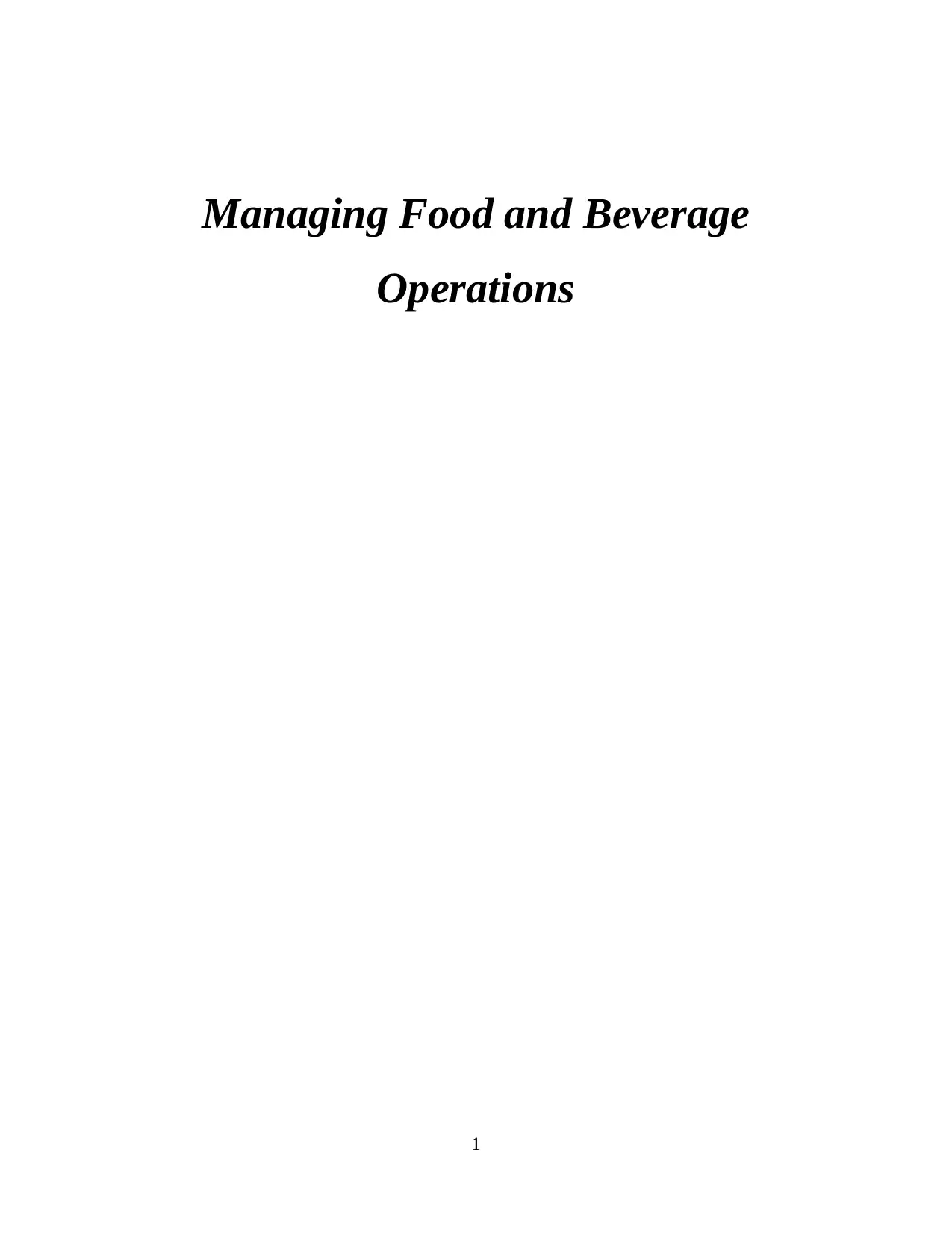
Managing Food and Beverage
Operations
1
Operations
1
Paraphrase This Document
Need a fresh take? Get an instant paraphrase of this document with our AI Paraphraser
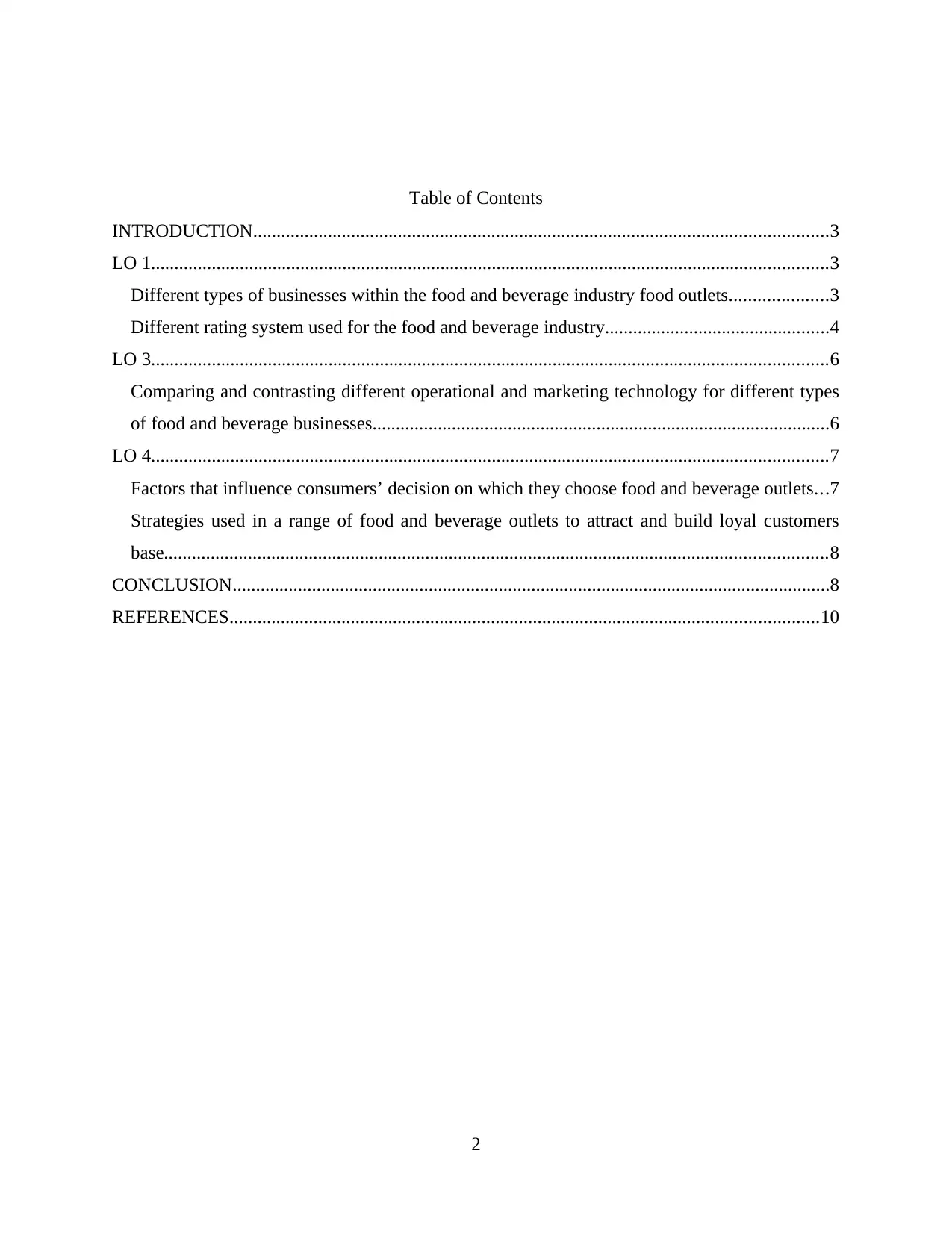
Table of Contents
INTRODUCTION...........................................................................................................................3
LO 1.................................................................................................................................................3
Different types of businesses within the food and beverage industry food outlets.....................3
Different rating system used for the food and beverage industry................................................4
LO 3.................................................................................................................................................6
Comparing and contrasting different operational and marketing technology for different types
of food and beverage businesses..................................................................................................6
LO 4.................................................................................................................................................7
Factors that influence consumers’ decision on which they choose food and beverage outlets...7
Strategies used in a range of food and beverage outlets to attract and build loyal customers
base..............................................................................................................................................8
CONCLUSION................................................................................................................................8
REFERENCES..............................................................................................................................10
2
INTRODUCTION...........................................................................................................................3
LO 1.................................................................................................................................................3
Different types of businesses within the food and beverage industry food outlets.....................3
Different rating system used for the food and beverage industry................................................4
LO 3.................................................................................................................................................6
Comparing and contrasting different operational and marketing technology for different types
of food and beverage businesses..................................................................................................6
LO 4.................................................................................................................................................7
Factors that influence consumers’ decision on which they choose food and beverage outlets...7
Strategies used in a range of food and beverage outlets to attract and build loyal customers
base..............................................................................................................................................8
CONCLUSION................................................................................................................................8
REFERENCES..............................................................................................................................10
2
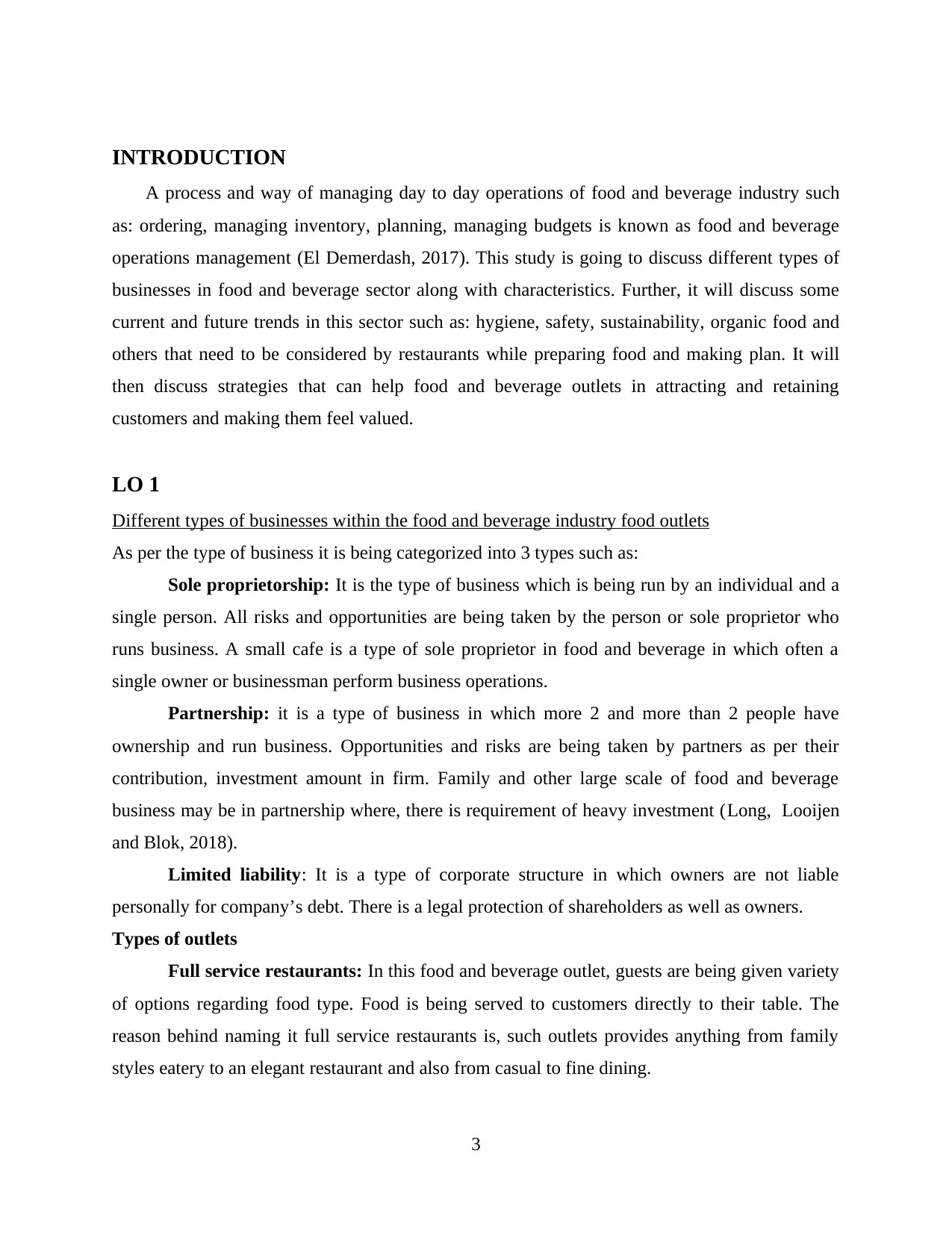
INTRODUCTION
A process and way of managing day to day operations of food and beverage industry such
as: ordering, managing inventory, planning, managing budgets is known as food and beverage
operations management (El Demerdash, 2017). This study is going to discuss different types of
businesses in food and beverage sector along with characteristics. Further, it will discuss some
current and future trends in this sector such as: hygiene, safety, sustainability, organic food and
others that need to be considered by restaurants while preparing food and making plan. It will
then discuss strategies that can help food and beverage outlets in attracting and retaining
customers and making them feel valued.
LO 1
Different types of businesses within the food and beverage industry food outlets
As per the type of business it is being categorized into 3 types such as:
Sole proprietorship: It is the type of business which is being run by an individual and a
single person. All risks and opportunities are being taken by the person or sole proprietor who
runs business. A small cafe is a type of sole proprietor in food and beverage in which often a
single owner or businessman perform business operations.
Partnership: it is a type of business in which more 2 and more than 2 people have
ownership and run business. Opportunities and risks are being taken by partners as per their
contribution, investment amount in firm. Family and other large scale of food and beverage
business may be in partnership where, there is requirement of heavy investment (Long, Looijen
and Blok, 2018).
Limited liability: It is a type of corporate structure in which owners are not liable
personally for company’s debt. There is a legal protection of shareholders as well as owners.
Types of outlets
Full service restaurants: In this food and beverage outlet, guests are being given variety
of options regarding food type. Food is being served to customers directly to their table. The
reason behind naming it full service restaurants is, such outlets provides anything from family
styles eatery to an elegant restaurant and also from casual to fine dining.
3
A process and way of managing day to day operations of food and beverage industry such
as: ordering, managing inventory, planning, managing budgets is known as food and beverage
operations management (El Demerdash, 2017). This study is going to discuss different types of
businesses in food and beverage sector along with characteristics. Further, it will discuss some
current and future trends in this sector such as: hygiene, safety, sustainability, organic food and
others that need to be considered by restaurants while preparing food and making plan. It will
then discuss strategies that can help food and beverage outlets in attracting and retaining
customers and making them feel valued.
LO 1
Different types of businesses within the food and beverage industry food outlets
As per the type of business it is being categorized into 3 types such as:
Sole proprietorship: It is the type of business which is being run by an individual and a
single person. All risks and opportunities are being taken by the person or sole proprietor who
runs business. A small cafe is a type of sole proprietor in food and beverage in which often a
single owner or businessman perform business operations.
Partnership: it is a type of business in which more 2 and more than 2 people have
ownership and run business. Opportunities and risks are being taken by partners as per their
contribution, investment amount in firm. Family and other large scale of food and beverage
business may be in partnership where, there is requirement of heavy investment (Long, Looijen
and Blok, 2018).
Limited liability: It is a type of corporate structure in which owners are not liable
personally for company’s debt. There is a legal protection of shareholders as well as owners.
Types of outlets
Full service restaurants: In this food and beverage outlet, guests are being given variety
of options regarding food type. Food is being served to customers directly to their table. The
reason behind naming it full service restaurants is, such outlets provides anything from family
styles eatery to an elegant restaurant and also from casual to fine dining.
3
⊘ This is a preview!⊘
Do you want full access?
Subscribe today to unlock all pages.

Trusted by 1+ million students worldwide
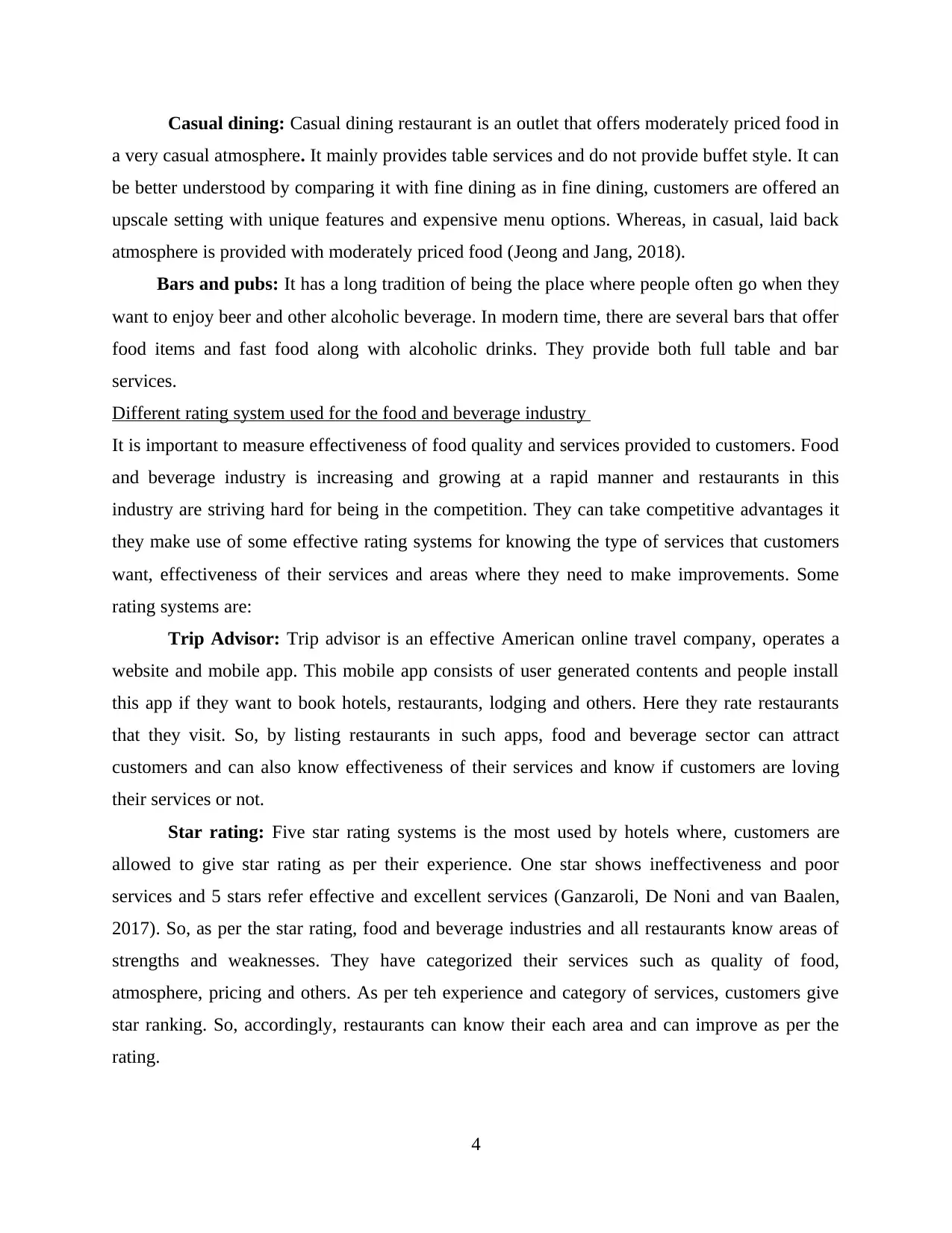
Casual dining: Casual dining restaurant is an outlet that offers moderately priced food in
a very casual atmosphere. It mainly provides table services and do not provide buffet style. It can
be better understood by comparing it with fine dining as in fine dining, customers are offered an
upscale setting with unique features and expensive menu options. Whereas, in casual, laid back
atmosphere is provided with moderately priced food (Jeong and Jang, 2018).
Bars and pubs: It has a long tradition of being the place where people often go when they
want to enjoy beer and other alcoholic beverage. In modern time, there are several bars that offer
food items and fast food along with alcoholic drinks. They provide both full table and bar
services.
Different rating system used for the food and beverage industry
It is important to measure effectiveness of food quality and services provided to customers. Food
and beverage industry is increasing and growing at a rapid manner and restaurants in this
industry are striving hard for being in the competition. They can take competitive advantages it
they make use of some effective rating systems for knowing the type of services that customers
want, effectiveness of their services and areas where they need to make improvements. Some
rating systems are:
Trip Advisor: Trip advisor is an effective American online travel company, operates a
website and mobile app. This mobile app consists of user generated contents and people install
this app if they want to book hotels, restaurants, lodging and others. Here they rate restaurants
that they visit. So, by listing restaurants in such apps, food and beverage sector can attract
customers and can also know effectiveness of their services and know if customers are loving
their services or not.
Star rating: Five star rating systems is the most used by hotels where, customers are
allowed to give star rating as per their experience. One star shows ineffectiveness and poor
services and 5 stars refer effective and excellent services (Ganzaroli, De Noni and van Baalen,
2017). So, as per the star rating, food and beverage industries and all restaurants know areas of
strengths and weaknesses. They have categorized their services such as quality of food,
atmosphere, pricing and others. As per teh experience and category of services, customers give
star ranking. So, accordingly, restaurants can know their each area and can improve as per the
rating.
4
a very casual atmosphere. It mainly provides table services and do not provide buffet style. It can
be better understood by comparing it with fine dining as in fine dining, customers are offered an
upscale setting with unique features and expensive menu options. Whereas, in casual, laid back
atmosphere is provided with moderately priced food (Jeong and Jang, 2018).
Bars and pubs: It has a long tradition of being the place where people often go when they
want to enjoy beer and other alcoholic beverage. In modern time, there are several bars that offer
food items and fast food along with alcoholic drinks. They provide both full table and bar
services.
Different rating system used for the food and beverage industry
It is important to measure effectiveness of food quality and services provided to customers. Food
and beverage industry is increasing and growing at a rapid manner and restaurants in this
industry are striving hard for being in the competition. They can take competitive advantages it
they make use of some effective rating systems for knowing the type of services that customers
want, effectiveness of their services and areas where they need to make improvements. Some
rating systems are:
Trip Advisor: Trip advisor is an effective American online travel company, operates a
website and mobile app. This mobile app consists of user generated contents and people install
this app if they want to book hotels, restaurants, lodging and others. Here they rate restaurants
that they visit. So, by listing restaurants in such apps, food and beverage sector can attract
customers and can also know effectiveness of their services and know if customers are loving
their services or not.
Star rating: Five star rating systems is the most used by hotels where, customers are
allowed to give star rating as per their experience. One star shows ineffectiveness and poor
services and 5 stars refer effective and excellent services (Ganzaroli, De Noni and van Baalen,
2017). So, as per the star rating, food and beverage industries and all restaurants know areas of
strengths and weaknesses. They have categorized their services such as quality of food,
atmosphere, pricing and others. As per teh experience and category of services, customers give
star ranking. So, accordingly, restaurants can know their each area and can improve as per the
rating.
4
Paraphrase This Document
Need a fresh take? Get an instant paraphrase of this document with our AI Paraphraser
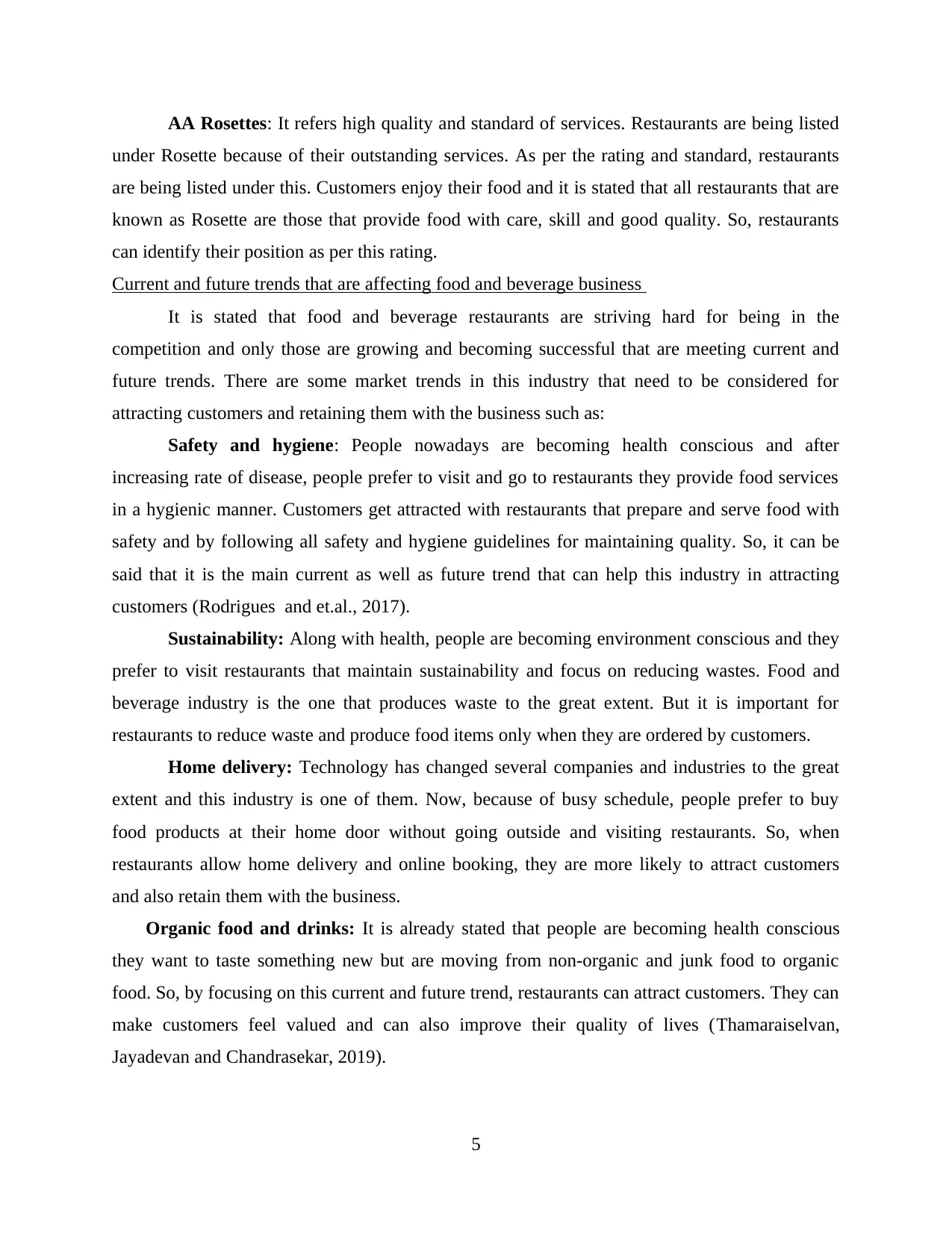
AA Rosettes: It refers high quality and standard of services. Restaurants are being listed
under Rosette because of their outstanding services. As per the rating and standard, restaurants
are being listed under this. Customers enjoy their food and it is stated that all restaurants that are
known as Rosette are those that provide food with care, skill and good quality. So, restaurants
can identify their position as per this rating.
Current and future trends that are affecting food and beverage business
It is stated that food and beverage restaurants are striving hard for being in the
competition and only those are growing and becoming successful that are meeting current and
future trends. There are some market trends in this industry that need to be considered for
attracting customers and retaining them with the business such as:
Safety and hygiene: People nowadays are becoming health conscious and after
increasing rate of disease, people prefer to visit and go to restaurants they provide food services
in a hygienic manner. Customers get attracted with restaurants that prepare and serve food with
safety and by following all safety and hygiene guidelines for maintaining quality. So, it can be
said that it is the main current as well as future trend that can help this industry in attracting
customers (Rodrigues and et.al., 2017).
Sustainability: Along with health, people are becoming environment conscious and they
prefer to visit restaurants that maintain sustainability and focus on reducing wastes. Food and
beverage industry is the one that produces waste to the great extent. But it is important for
restaurants to reduce waste and produce food items only when they are ordered by customers.
Home delivery: Technology has changed several companies and industries to the great
extent and this industry is one of them. Now, because of busy schedule, people prefer to buy
food products at their home door without going outside and visiting restaurants. So, when
restaurants allow home delivery and online booking, they are more likely to attract customers
and also retain them with the business.
Organic food and drinks: It is already stated that people are becoming health conscious
they want to taste something new but are moving from non-organic and junk food to organic
food. So, by focusing on this current and future trend, restaurants can attract customers. They can
make customers feel valued and can also improve their quality of lives (Thamaraiselvan,
Jayadevan and Chandrasekar, 2019).
5
under Rosette because of their outstanding services. As per the rating and standard, restaurants
are being listed under this. Customers enjoy their food and it is stated that all restaurants that are
known as Rosette are those that provide food with care, skill and good quality. So, restaurants
can identify their position as per this rating.
Current and future trends that are affecting food and beverage business
It is stated that food and beverage restaurants are striving hard for being in the
competition and only those are growing and becoming successful that are meeting current and
future trends. There are some market trends in this industry that need to be considered for
attracting customers and retaining them with the business such as:
Safety and hygiene: People nowadays are becoming health conscious and after
increasing rate of disease, people prefer to visit and go to restaurants they provide food services
in a hygienic manner. Customers get attracted with restaurants that prepare and serve food with
safety and by following all safety and hygiene guidelines for maintaining quality. So, it can be
said that it is the main current as well as future trend that can help this industry in attracting
customers (Rodrigues and et.al., 2017).
Sustainability: Along with health, people are becoming environment conscious and they
prefer to visit restaurants that maintain sustainability and focus on reducing wastes. Food and
beverage industry is the one that produces waste to the great extent. But it is important for
restaurants to reduce waste and produce food items only when they are ordered by customers.
Home delivery: Technology has changed several companies and industries to the great
extent and this industry is one of them. Now, because of busy schedule, people prefer to buy
food products at their home door without going outside and visiting restaurants. So, when
restaurants allow home delivery and online booking, they are more likely to attract customers
and also retain them with the business.
Organic food and drinks: It is already stated that people are becoming health conscious
they want to taste something new but are moving from non-organic and junk food to organic
food. So, by focusing on this current and future trend, restaurants can attract customers. They can
make customers feel valued and can also improve their quality of lives (Thamaraiselvan,
Jayadevan and Chandrasekar, 2019).
5
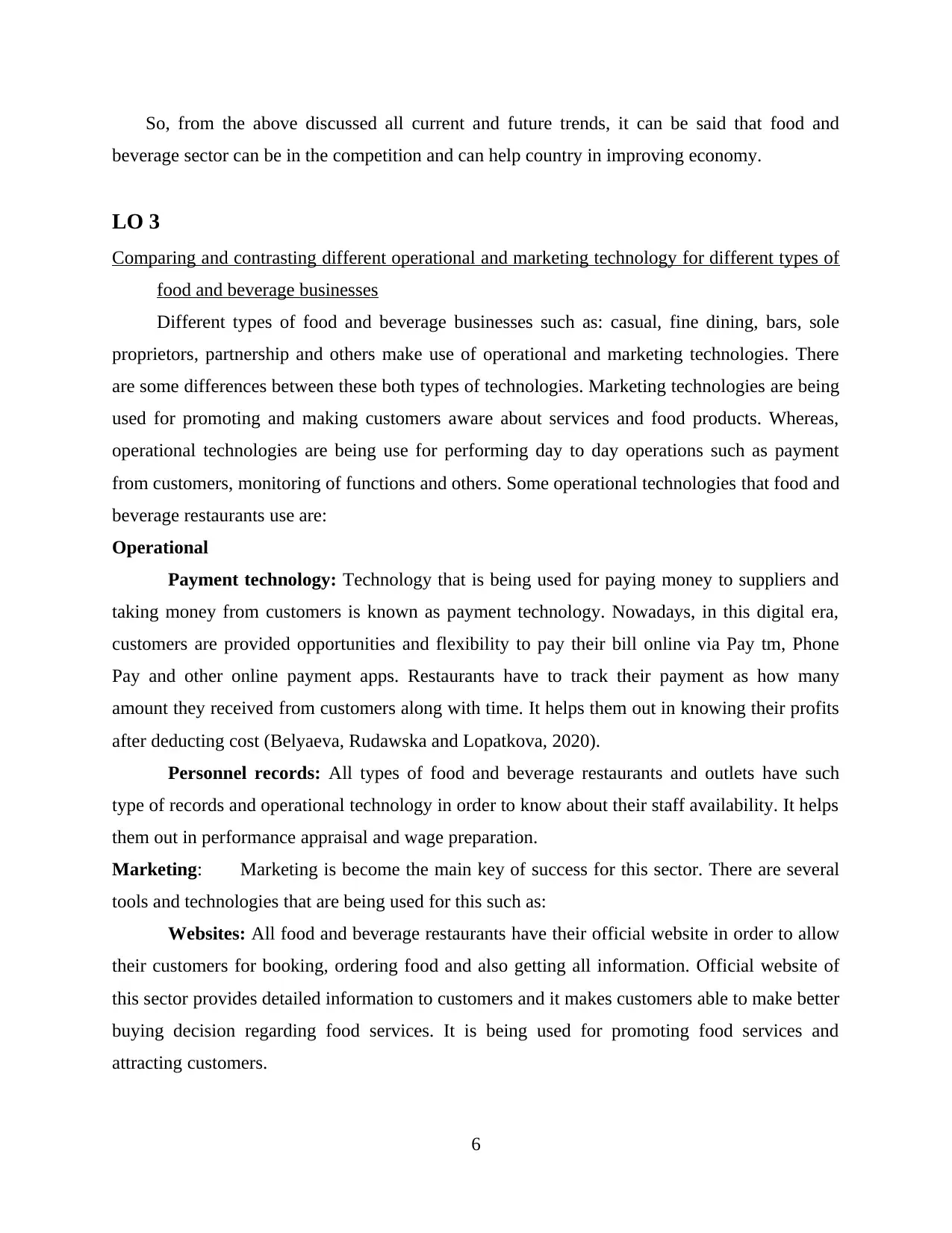
So, from the above discussed all current and future trends, it can be said that food and
beverage sector can be in the competition and can help country in improving economy.
LO 3
Comparing and contrasting different operational and marketing technology for different types of
food and beverage businesses
Different types of food and beverage businesses such as: casual, fine dining, bars, sole
proprietors, partnership and others make use of operational and marketing technologies. There
are some differences between these both types of technologies. Marketing technologies are being
used for promoting and making customers aware about services and food products. Whereas,
operational technologies are being use for performing day to day operations such as payment
from customers, monitoring of functions and others. Some operational technologies that food and
beverage restaurants use are:
Operational
Payment technology: Technology that is being used for paying money to suppliers and
taking money from customers is known as payment technology. Nowadays, in this digital era,
customers are provided opportunities and flexibility to pay their bill online via Pay tm, Phone
Pay and other online payment apps. Restaurants have to track their payment as how many
amount they received from customers along with time. It helps them out in knowing their profits
after deducting cost (Belyaeva, Rudawska and Lopatkova, 2020).
Personnel records: All types of food and beverage restaurants and outlets have such
type of records and operational technology in order to know about their staff availability. It helps
them out in performance appraisal and wage preparation.
Marketing: Marketing is become the main key of success for this sector. There are several
tools and technologies that are being used for this such as:
Websites: All food and beverage restaurants have their official website in order to allow
their customers for booking, ordering food and also getting all information. Official website of
this sector provides detailed information to customers and it makes customers able to make better
buying decision regarding food services. It is being used for promoting food services and
attracting customers.
6
beverage sector can be in the competition and can help country in improving economy.
LO 3
Comparing and contrasting different operational and marketing technology for different types of
food and beverage businesses
Different types of food and beverage businesses such as: casual, fine dining, bars, sole
proprietors, partnership and others make use of operational and marketing technologies. There
are some differences between these both types of technologies. Marketing technologies are being
used for promoting and making customers aware about services and food products. Whereas,
operational technologies are being use for performing day to day operations such as payment
from customers, monitoring of functions and others. Some operational technologies that food and
beverage restaurants use are:
Operational
Payment technology: Technology that is being used for paying money to suppliers and
taking money from customers is known as payment technology. Nowadays, in this digital era,
customers are provided opportunities and flexibility to pay their bill online via Pay tm, Phone
Pay and other online payment apps. Restaurants have to track their payment as how many
amount they received from customers along with time. It helps them out in knowing their profits
after deducting cost (Belyaeva, Rudawska and Lopatkova, 2020).
Personnel records: All types of food and beverage restaurants and outlets have such
type of records and operational technology in order to know about their staff availability. It helps
them out in performance appraisal and wage preparation.
Marketing: Marketing is become the main key of success for this sector. There are several
tools and technologies that are being used for this such as:
Websites: All food and beverage restaurants have their official website in order to allow
their customers for booking, ordering food and also getting all information. Official website of
this sector provides detailed information to customers and it makes customers able to make better
buying decision regarding food services. It is being used for promoting food services and
attracting customers.
6
⊘ This is a preview!⊘
Do you want full access?
Subscribe today to unlock all pages.

Trusted by 1+ million students worldwide
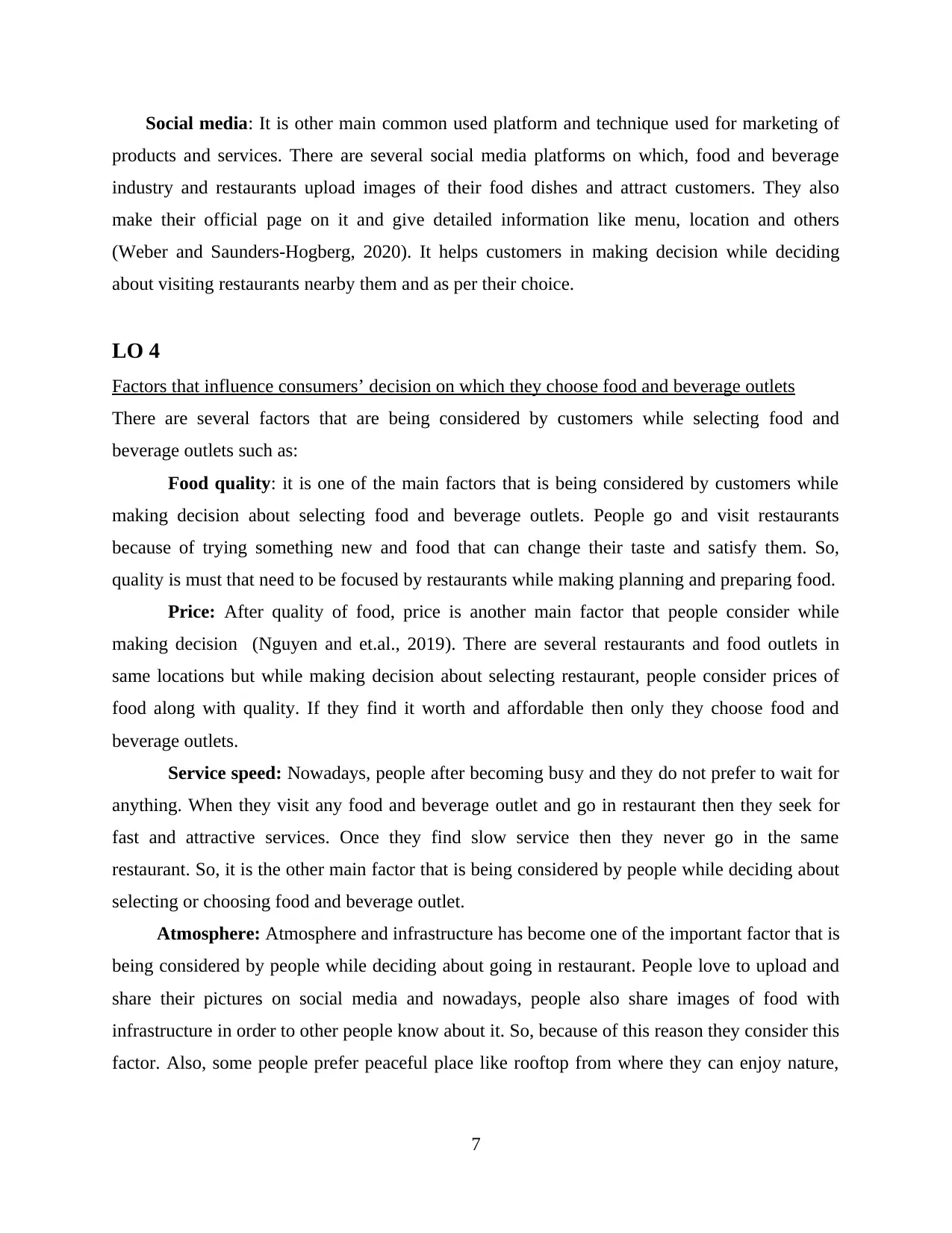
Social media: It is other main common used platform and technique used for marketing of
products and services. There are several social media platforms on which, food and beverage
industry and restaurants upload images of their food dishes and attract customers. They also
make their official page on it and give detailed information like menu, location and others
(Weber and Saunders‐Hogberg, 2020). It helps customers in making decision while deciding
about visiting restaurants nearby them and as per their choice.
LO 4
Factors that influence consumers’ decision on which they choose food and beverage outlets
There are several factors that are being considered by customers while selecting food and
beverage outlets such as:
Food quality: it is one of the main factors that is being considered by customers while
making decision about selecting food and beverage outlets. People go and visit restaurants
because of trying something new and food that can change their taste and satisfy them. So,
quality is must that need to be focused by restaurants while making planning and preparing food.
Price: After quality of food, price is another main factor that people consider while
making decision (Nguyen and et.al., 2019). There are several restaurants and food outlets in
same locations but while making decision about selecting restaurant, people consider prices of
food along with quality. If they find it worth and affordable then only they choose food and
beverage outlets.
Service speed: Nowadays, people after becoming busy and they do not prefer to wait for
anything. When they visit any food and beverage outlet and go in restaurant then they seek for
fast and attractive services. Once they find slow service then they never go in the same
restaurant. So, it is the other main factor that is being considered by people while deciding about
selecting or choosing food and beverage outlet.
Atmosphere: Atmosphere and infrastructure has become one of the important factor that is
being considered by people while deciding about going in restaurant. People love to upload and
share their pictures on social media and nowadays, people also share images of food with
infrastructure in order to other people know about it. So, because of this reason they consider this
factor. Also, some people prefer peaceful place like rooftop from where they can enjoy nature,
7
products and services. There are several social media platforms on which, food and beverage
industry and restaurants upload images of their food dishes and attract customers. They also
make their official page on it and give detailed information like menu, location and others
(Weber and Saunders‐Hogberg, 2020). It helps customers in making decision while deciding
about visiting restaurants nearby them and as per their choice.
LO 4
Factors that influence consumers’ decision on which they choose food and beverage outlets
There are several factors that are being considered by customers while selecting food and
beverage outlets such as:
Food quality: it is one of the main factors that is being considered by customers while
making decision about selecting food and beverage outlets. People go and visit restaurants
because of trying something new and food that can change their taste and satisfy them. So,
quality is must that need to be focused by restaurants while making planning and preparing food.
Price: After quality of food, price is another main factor that people consider while
making decision (Nguyen and et.al., 2019). There are several restaurants and food outlets in
same locations but while making decision about selecting restaurant, people consider prices of
food along with quality. If they find it worth and affordable then only they choose food and
beverage outlets.
Service speed: Nowadays, people after becoming busy and they do not prefer to wait for
anything. When they visit any food and beverage outlet and go in restaurant then they seek for
fast and attractive services. Once they find slow service then they never go in the same
restaurant. So, it is the other main factor that is being considered by people while deciding about
selecting or choosing food and beverage outlet.
Atmosphere: Atmosphere and infrastructure has become one of the important factor that is
being considered by people while deciding about going in restaurant. People love to upload and
share their pictures on social media and nowadays, people also share images of food with
infrastructure in order to other people know about it. So, because of this reason they consider this
factor. Also, some people prefer peaceful place like rooftop from where they can enjoy nature,
7
Paraphrase This Document
Need a fresh take? Get an instant paraphrase of this document with our AI Paraphraser
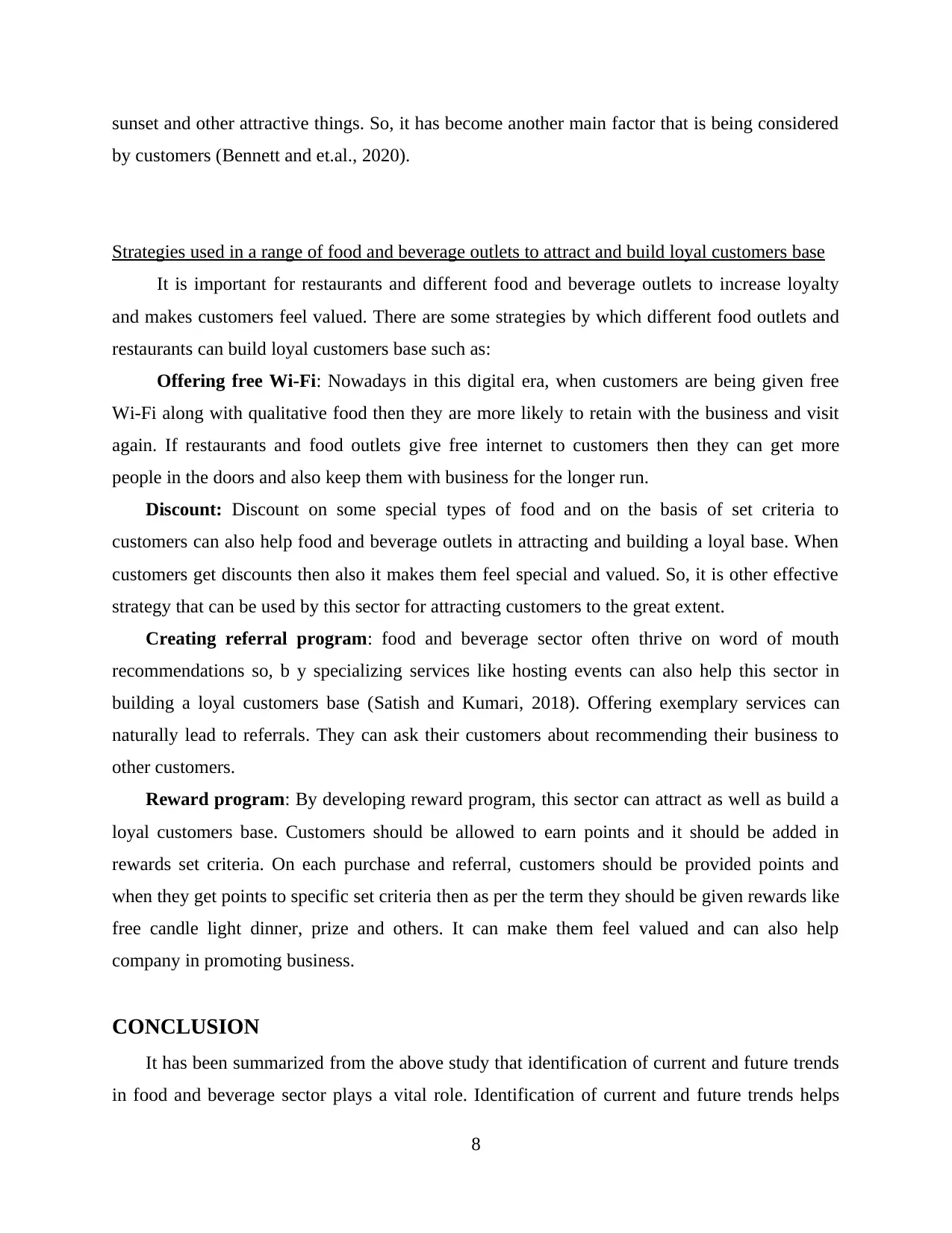
sunset and other attractive things. So, it has become another main factor that is being considered
by customers (Bennett and et.al., 2020).
Strategies used in a range of food and beverage outlets to attract and build loyal customers base
It is important for restaurants and different food and beverage outlets to increase loyalty
and makes customers feel valued. There are some strategies by which different food outlets and
restaurants can build loyal customers base such as:
Offering free Wi-Fi: Nowadays in this digital era, when customers are being given free
Wi-Fi along with qualitative food then they are more likely to retain with the business and visit
again. If restaurants and food outlets give free internet to customers then they can get more
people in the doors and also keep them with business for the longer run.
Discount: Discount on some special types of food and on the basis of set criteria to
customers can also help food and beverage outlets in attracting and building a loyal base. When
customers get discounts then also it makes them feel special and valued. So, it is other effective
strategy that can be used by this sector for attracting customers to the great extent.
Creating referral program: food and beverage sector often thrive on word of mouth
recommendations so, b y specializing services like hosting events can also help this sector in
building a loyal customers base (Satish and Kumari, 2018). Offering exemplary services can
naturally lead to referrals. They can ask their customers about recommending their business to
other customers.
Reward program: By developing reward program, this sector can attract as well as build a
loyal customers base. Customers should be allowed to earn points and it should be added in
rewards set criteria. On each purchase and referral, customers should be provided points and
when they get points to specific set criteria then as per the term they should be given rewards like
free candle light dinner, prize and others. It can make them feel valued and can also help
company in promoting business.
CONCLUSION
It has been summarized from the above study that identification of current and future trends
in food and beverage sector plays a vital role. Identification of current and future trends helps
8
by customers (Bennett and et.al., 2020).
Strategies used in a range of food and beverage outlets to attract and build loyal customers base
It is important for restaurants and different food and beverage outlets to increase loyalty
and makes customers feel valued. There are some strategies by which different food outlets and
restaurants can build loyal customers base such as:
Offering free Wi-Fi: Nowadays in this digital era, when customers are being given free
Wi-Fi along with qualitative food then they are more likely to retain with the business and visit
again. If restaurants and food outlets give free internet to customers then they can get more
people in the doors and also keep them with business for the longer run.
Discount: Discount on some special types of food and on the basis of set criteria to
customers can also help food and beverage outlets in attracting and building a loyal base. When
customers get discounts then also it makes them feel special and valued. So, it is other effective
strategy that can be used by this sector for attracting customers to the great extent.
Creating referral program: food and beverage sector often thrive on word of mouth
recommendations so, b y specializing services like hosting events can also help this sector in
building a loyal customers base (Satish and Kumari, 2018). Offering exemplary services can
naturally lead to referrals. They can ask their customers about recommending their business to
other customers.
Reward program: By developing reward program, this sector can attract as well as build a
loyal customers base. Customers should be allowed to earn points and it should be added in
rewards set criteria. On each purchase and referral, customers should be provided points and
when they get points to specific set criteria then as per the term they should be given rewards like
free candle light dinner, prize and others. It can make them feel valued and can also help
company in promoting business.
CONCLUSION
It has been summarized from the above study that identification of current and future trends
in food and beverage sector plays a vital role. Identification of current and future trends helps
8
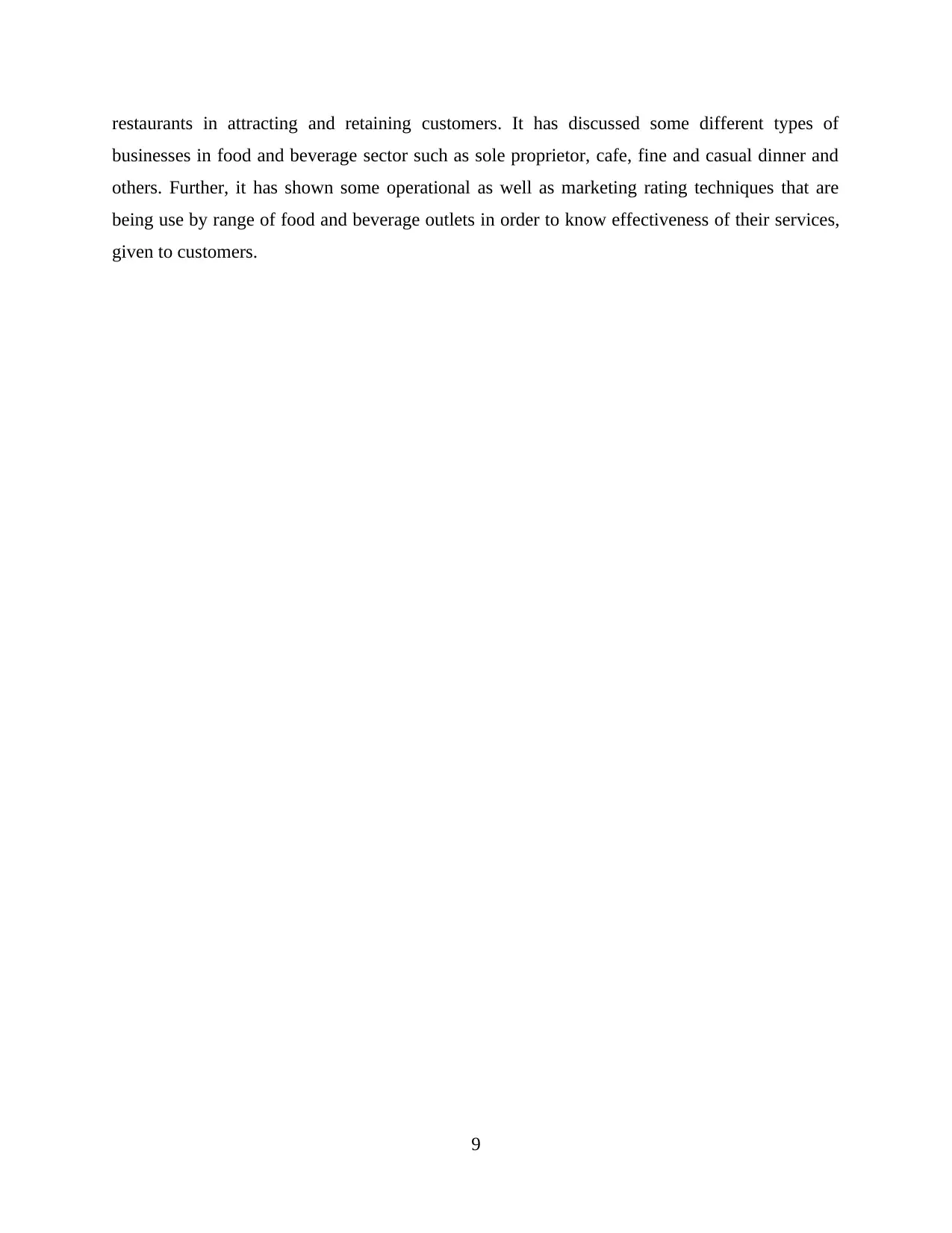
restaurants in attracting and retaining customers. It has discussed some different types of
businesses in food and beverage sector such as sole proprietor, cafe, fine and casual dinner and
others. Further, it has shown some operational as well as marketing rating techniques that are
being use by range of food and beverage outlets in order to know effectiveness of their services,
given to customers.
9
businesses in food and beverage sector such as sole proprietor, cafe, fine and casual dinner and
others. Further, it has shown some operational as well as marketing rating techniques that are
being use by range of food and beverage outlets in order to know effectiveness of their services,
given to customers.
9
⊘ This is a preview!⊘
Do you want full access?
Subscribe today to unlock all pages.

Trusted by 1+ million students worldwide
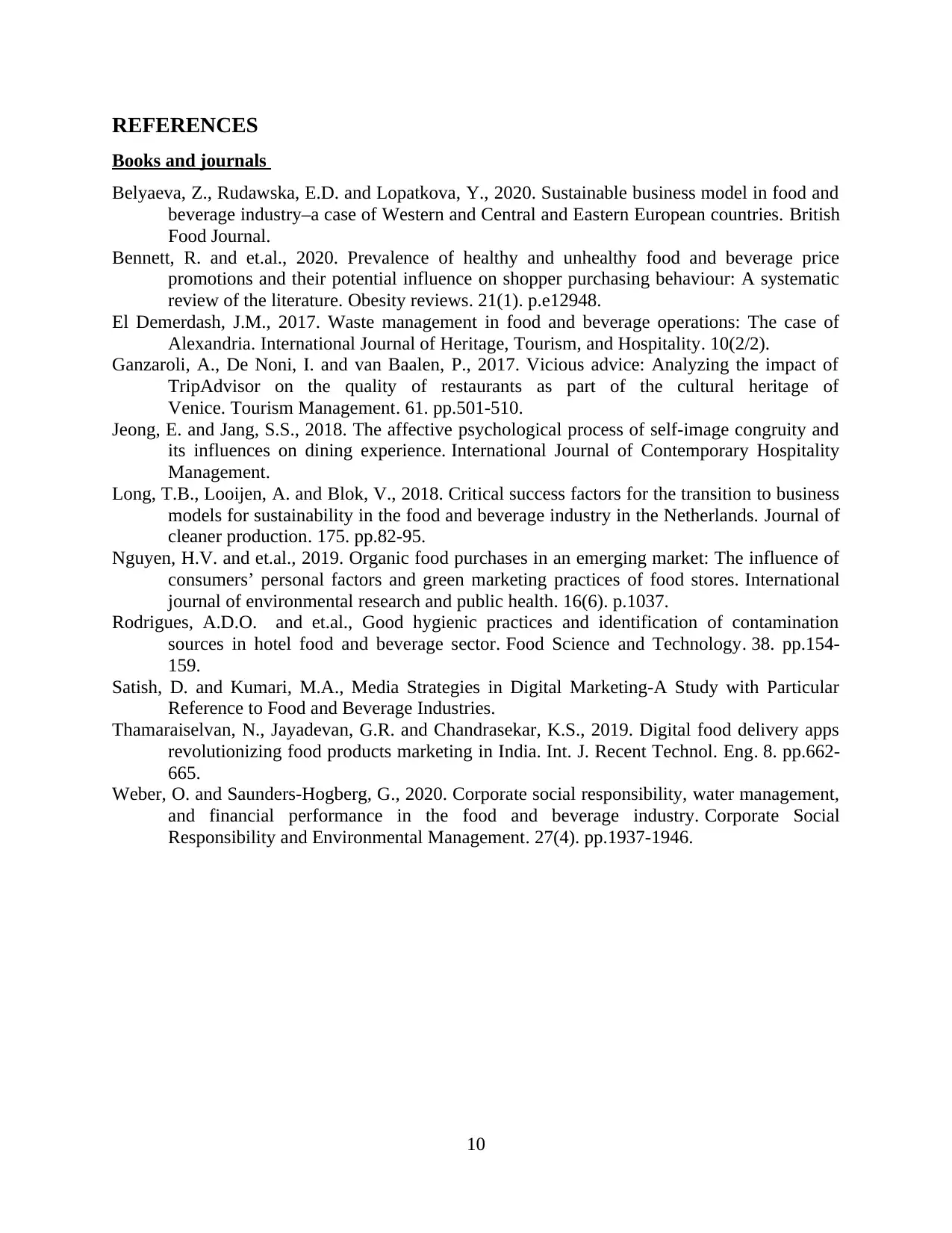
REFERENCES
Books and journals
Belyaeva, Z., Rudawska, E.D. and Lopatkova, Y., 2020. Sustainable business model in food and
beverage industry–a case of Western and Central and Eastern European countries. British
Food Journal.
Bennett, R. and et.al., 2020. Prevalence of healthy and unhealthy food and beverage price
promotions and their potential influence on shopper purchasing behaviour: A systematic
review of the literature. Obesity reviews. 21(1). p.e12948.
El Demerdash, J.M., 2017. Waste management in food and beverage operations: The case of
Alexandria. International Journal of Heritage, Tourism, and Hospitality. 10(2/2).
Ganzaroli, A., De Noni, I. and van Baalen, P., 2017. Vicious advice: Analyzing the impact of
TripAdvisor on the quality of restaurants as part of the cultural heritage of
Venice. Tourism Management. 61. pp.501-510.
Jeong, E. and Jang, S.S., 2018. The affective psychological process of self-image congruity and
its influences on dining experience. International Journal of Contemporary Hospitality
Management.
Long, T.B., Looijen, A. and Blok, V., 2018. Critical success factors for the transition to business
models for sustainability in the food and beverage industry in the Netherlands. Journal of
cleaner production. 175. pp.82-95.
Nguyen, H.V. and et.al., 2019. Organic food purchases in an emerging market: The influence of
consumers’ personal factors and green marketing practices of food stores. International
journal of environmental research and public health. 16(6). p.1037.
Rodrigues, A.D.O. and et.al., Good hygienic practices and identification of contamination
sources in hotel food and beverage sector. Food Science and Technology. 38. pp.154-
159.
Satish, D. and Kumari, M.A., Media Strategies in Digital Marketing-A Study with Particular
Reference to Food and Beverage Industries.
Thamaraiselvan, N., Jayadevan, G.R. and Chandrasekar, K.S., 2019. Digital food delivery apps
revolutionizing food products marketing in India. Int. J. Recent Technol. Eng. 8. pp.662-
665.
Weber, O. and Saunders‐Hogberg, G., 2020. Corporate social responsibility, water management,
and financial performance in the food and beverage industry. Corporate Social
Responsibility and Environmental Management. 27(4). pp.1937-1946.
10
Books and journals
Belyaeva, Z., Rudawska, E.D. and Lopatkova, Y., 2020. Sustainable business model in food and
beverage industry–a case of Western and Central and Eastern European countries. British
Food Journal.
Bennett, R. and et.al., 2020. Prevalence of healthy and unhealthy food and beverage price
promotions and their potential influence on shopper purchasing behaviour: A systematic
review of the literature. Obesity reviews. 21(1). p.e12948.
El Demerdash, J.M., 2017. Waste management in food and beverage operations: The case of
Alexandria. International Journal of Heritage, Tourism, and Hospitality. 10(2/2).
Ganzaroli, A., De Noni, I. and van Baalen, P., 2017. Vicious advice: Analyzing the impact of
TripAdvisor on the quality of restaurants as part of the cultural heritage of
Venice. Tourism Management. 61. pp.501-510.
Jeong, E. and Jang, S.S., 2018. The affective psychological process of self-image congruity and
its influences on dining experience. International Journal of Contemporary Hospitality
Management.
Long, T.B., Looijen, A. and Blok, V., 2018. Critical success factors for the transition to business
models for sustainability in the food and beverage industry in the Netherlands. Journal of
cleaner production. 175. pp.82-95.
Nguyen, H.V. and et.al., 2019. Organic food purchases in an emerging market: The influence of
consumers’ personal factors and green marketing practices of food stores. International
journal of environmental research and public health. 16(6). p.1037.
Rodrigues, A.D.O. and et.al., Good hygienic practices and identification of contamination
sources in hotel food and beverage sector. Food Science and Technology. 38. pp.154-
159.
Satish, D. and Kumari, M.A., Media Strategies in Digital Marketing-A Study with Particular
Reference to Food and Beverage Industries.
Thamaraiselvan, N., Jayadevan, G.R. and Chandrasekar, K.S., 2019. Digital food delivery apps
revolutionizing food products marketing in India. Int. J. Recent Technol. Eng. 8. pp.662-
665.
Weber, O. and Saunders‐Hogberg, G., 2020. Corporate social responsibility, water management,
and financial performance in the food and beverage industry. Corporate Social
Responsibility and Environmental Management. 27(4). pp.1937-1946.
10
Paraphrase This Document
Need a fresh take? Get an instant paraphrase of this document with our AI Paraphraser

11
1 out of 11
Related Documents
Your All-in-One AI-Powered Toolkit for Academic Success.
+13062052269
info@desklib.com
Available 24*7 on WhatsApp / Email
![[object Object]](/_next/static/media/star-bottom.7253800d.svg)
Unlock your academic potential
Copyright © 2020–2025 A2Z Services. All Rights Reserved. Developed and managed by ZUCOL.




